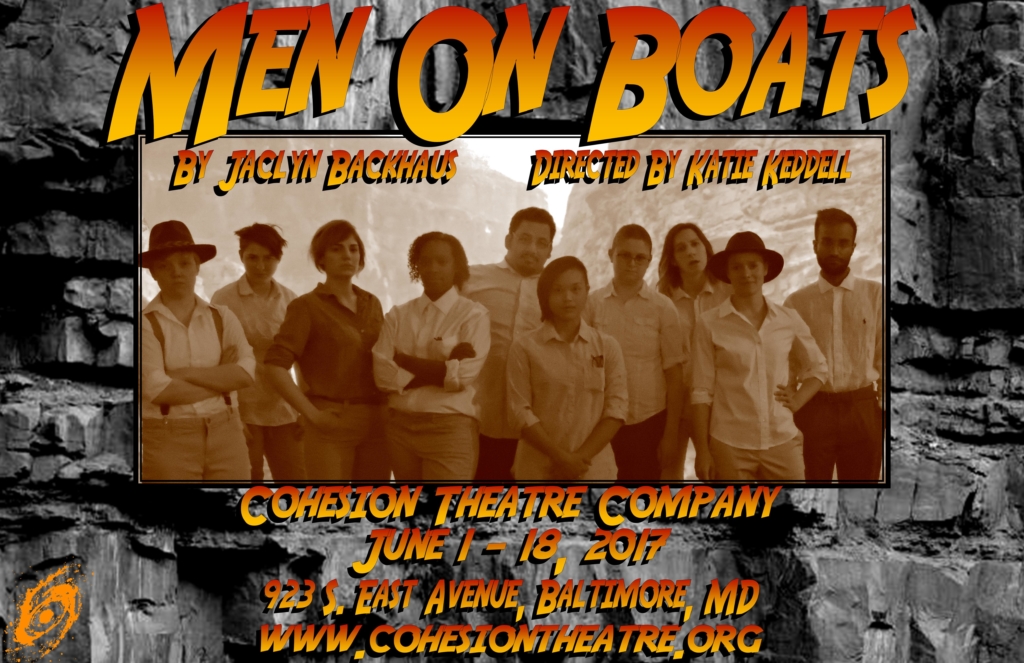Water takes the boat people. Water catch ‘em. Water keep ‘em. A cautionary warning to those brave enough, or perhaps foolish enough, to strike out on a Government sanctioned expedition down the Colorado River through the uncharted “Big Canyon” (what we know now as The Grand Canyon) in 1869. Are you brave enough, or perhaps foolish enough, to join Cohesion Theatre Company as their close out their third season with Men on Boats, a play Jaclyn Backhaus that theatricalizes the actual journey taken by General John Wesley Powell and his men in their boats? Directed by Katie Keddell, this perilous adventure is fraught with excitement; there’s a glorious set, exceptional sound design, and strong performances to be had all along the big canyon and the road to discovery.
Wonderment will give the audience great pause as they stare at the all-consuming scenery, fabricated by Set Designer Brad Norris (and the scenic painting of Haley Horton.) The rocky cavernous walls of the canyon climb from the ground of the space nearly to the ceiling, turning the United Evangelical Church’s Fallout Shelter into something remarkable. With the canyon ledges and floor painted to represent the river, it’s almost like being there with the men on the boats! Accented with illumination by way of Lighting Designer Lana Riggins, you can almost see the grandeur that these men describe when discovering bits of the canyon for the very first time. Add to this the transformative and transportative Sound Designs of Max Garner, who appropriately swells volume and intensity of the river when the crew faces rougher rapids and waterfalls to deeply authenticate the overall experience, and you have a fully involved experience. So close to the river’s edge is the audience seated that if you’re not careful, you might just end up in one of the boats!
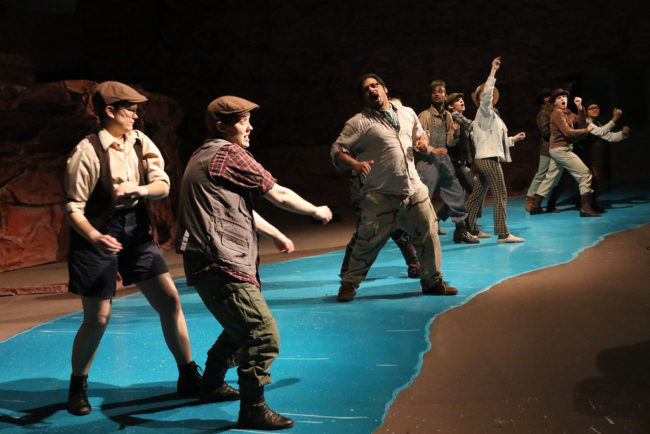
Director Katie Keddell is smart in not physicalizing the boats on the journey. An audience will readily suspend its disbelief for invisible or pretend boats when the actors in them are so thoroughly physically invested in the gestures of rowing and pitching about when the waters get rough. Keddell, however, misses an enormous opportunity to keep the audience fully engaged with all the nuances of the play’s plot when it comes to General Powell. The character, as in real life history— and so too mentioned throughout the play as well as in the notes of the program— is missing an arm. Keddell does nothing with the actor playing Powell to indicate this, which is somewhat problematic for scenes when Powell is in danger— like hanging off the side of the cliff. A simple “dead-arming” would suffice (no need to bandage or bind) to fix this missed opportunity and keep the audience from being distracted or confused.
Keddell makes bold choices with the way the show is cast, using predominantly female and non-gender binary performers in all but two roles; all of the characters are historically male. This is a wonderful showcase of gendergy— playing with gender energies through cross, mixed, and gender-blind casting— and really puts a unique and refreshing spin on history. The performances are impressive across the board, each individual holding their own in this ensemble-driven piece. The ensemble plays well together, each taking their cues from others; all of them finding their footholds in the thrill of the adventure, the desperation of hoping for survival, and the overall fascination of new discovery for the time.
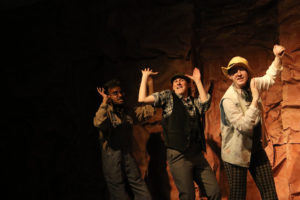
Seneca (Caitlin Carbone) and O.G. (Utkarsh Rajawat) are thick as thieves; being brothers this relationship feels strikingly natural. They’re both a bit cheeky and snarky and a bit edgy when it comes to the spitfire accusations that camp hunter/fisher/cooker Hawkins (Logan Davidson) throws around. Davidson, who is a burst of raw energy and constantly looking to scrap about for some sort of fight— however trivial— is a rogue paddle that just keeps rowing even when others are at rest. With sprightly and animated eyes, Davidson’s portrayal of Hawkins is among the many that stand out as memorable over the course of the evening, not for any one particular line or conflict but because they are constantly bursting out.
Goodman (Jane Jongeward) takes up space and eats all the bacon. Jongeward’s mildly affected British accent serves the character well, giving Goodman a posh and somewhat prissy air, which sets the native Englander apart from the other men on the journey. Jongeward, who carries their energy mostly internally, does an exceptional job of physicalizing distress when pitched overboard in various incidences of boats capsizing. Equally notable for an affected performance is Alice Stanely in the role of Hall. The company cartographer, Stanley’s portrayal of Hall augments the meager and meek qualities that Backhaus has ascribed to the map-maker. Stanley does hold their own, however, when being called out for questionable map-making, and rises readily to the challenge, defending their work with rigor. Watch Stanley’s physicality closely as it shifts through various stages of internal closeness, indicating just how uncertain and isolated the character is feeling moment to moment.
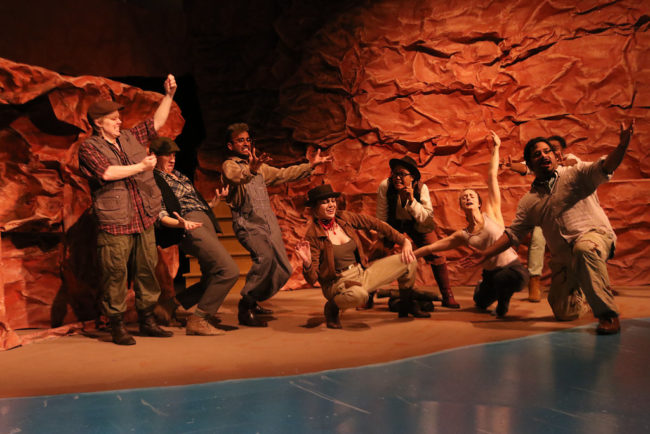
Old Shady (Just Lawson Isett) tends to be the peace keeper among the group. Quiet and reserved and rarely with words, Isett is a sturdy branch in the tree of explorers that sets out to unfurl its roots along the Grand Canyon. Serving as the show’s musical director in addition to performing, Isett leads the songs whenever they overtake a particularly tense scene during the show. With a glorious voice that well echoes the sentiments and styles of folk tunes on the river, Isett works these moments over like a fine baker kneading dough, massaging them into something truly spectacular; what show doesn’t need a bit of music every now and again? And this show certainly benefits from Isett’s musical work.
Loaded with an entire canyon of sparky energy, Bradley (Martha Robichaud) is the newcomer to the expedition and is more than green around the ears, thumbs, and everywhere else. Robichaud does an exceptional job of channeling this spunky personality that really pips up, a bit too often if the responses of the other characters are any indication. The polar opposite of the Bradley character is Sumner (Emily Classen) who is much more grounded and reserved. Classen, who is most active during the actual boating scenes— seen leaning hard in and out of the boats, bending and flexing with the rush and flow of the unseen water— uses her full body as well as her facial expressions to carry out the internal monologue of her character throughout the production.
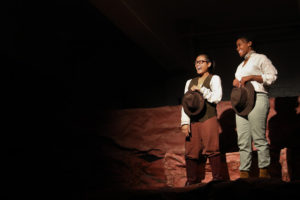
Dunn (Cori Dioquino) and Powell (Bethany Mayo) are the charging forces of the team. Though all throughout the production Dioquino’s character and Mayo’s character fall on different sides of the coin, their initial camaraderie is strong. There is a stunning moment shared between Dioquino and Mayo when discovering Dunn’s cliff, which feels raw and inspiring; this moment is one of the most pristinely beautiful in the production. They bristle frequently with one another, each finding a balance so as not to overstep their bounds with the other too far. Both Dioquino and Mayo are the loudest voices when the boats are in motion; this too occurs in earnest as they are natural born leaders of the pack and would be shouting out the commands to others.
There is a great deal of adventure and excitement to experience with these Men on Boats and this is one production that should not rush off into the sunset before you get a chance to see it.
Running Time: Approximately 1 hour and 45 minutes with one intermission
Men On Boats plays through June 18, 2017 at Cohesion Theatre Company in the Fallout Shelter of the United Evangelical Church— 3200 Dillon Street in the Canton neighborhood of Baltimore, MD. Tickets are available at the door or in advance online.

